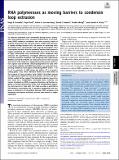RNA polymerases as moving barriers to condensin loop extrusion
Author(s)
Brandao, Hugo B.; Paul, Payel; van den Berg, Aafke A; Rudner, David Z.; Wang, Xindan; Mirny, Leonid A; ... Show more Show less
DownloadPublished version (1.905Mb)
Terms of use
Metadata
Show full item recordAbstract
To separate replicated sister chromatids during mitosis, eukaryotes and prokaryotes have structural maintenance of chromosome (SMC) condensin complexes that were recently shown to organize chromosomes by a process known as DNA loop extrusion. In rapidly dividing bacterial cells, the process of separating sister chromatids occurs concomitantly with ongoing transcription. How transcription interferes with the condensin loop-extrusion process is largely unexplored, but recent experiments have shown that sites of high transcription may directionally affect condensin loop extrusion. We quantitatively investigate different mechanisms of interaction between condensin and elongating RNA polymerases (RNAPs) and find that RNAPs are likely steric barriers that can push and interact with condensins. Supported by chromosome conformation capture and chromatin immunoprecipitation for cells after transcription inhibition and RNAP degradation, we argue that translocating condensins must bypass transcribing RNAPs within ∼1 to 2 s of an encounter at rRNA genes and within ∼10 s at protein-coding genes. Thus, while individual RNAPs have little effect on the progress of loop extrusion, long, highly transcribed operons can significantly impede the extrusion process. Our data and quantitative models further suggest that bacterial condensin loop extrusion occurs by 2 independent, uncoupled motor activities; the motors translocate on DNA in opposing directions and function together to enlarge chromosomal loops, each independently bypassing steric barriers in their path. Our study provides a quantitative link between transcription and 3D genome organization and proposes a mechanism of interactions between SMC complexes and elongating transcription machinery relevant from bacteria to higher eukaryotes.
Date issued
2019-09Department
Massachusetts Institute of Technology. Institute for Medical Engineering & Science; Massachusetts Institute of Technology. Department of PhysicsJournal
PNAS
Publisher
Proceedings of the National Academy of Sciences
Citation
Brandão, Hugo B., et al. RNA polymerases as moving barriers to condensin loop extrusion. Proceedings of the National Academy of Sciences 116, 41 (October 2019): 20489-20499 Copyright © 2019 the Author(s)
Version: Final published version
ISSN
0027-8424